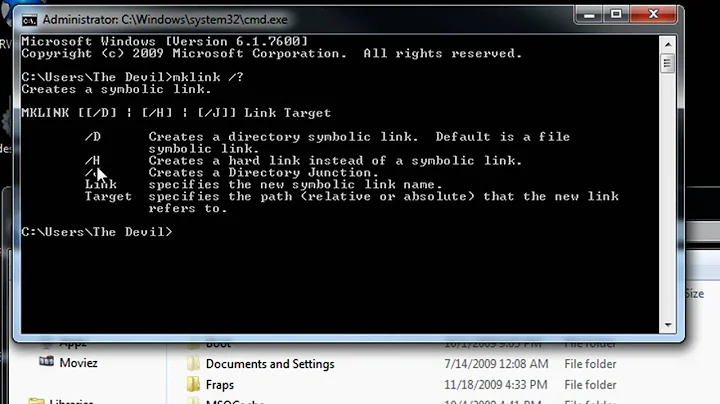MKLINK vs. Junction.exe
Solution 1
Comparison
Mark Russinovich's junction program was designed with a specific goal in mind: create (and delete) junction points. It was maintained through the years, but no new features were added so far. The latest version was released on July 4, 2016.
As for mklink, it's a built-in command available in Windows Vista and later. It can create hard links, junction points, and symbolic links. A specific delete function is not provided; you can simply use the del or rd commands, depending on whether the link points to a file or a directory, respectively.
A bit of history
Prior to Vista, Windows operating systems didn't provide a way to create junction points out of the box: you either had to get a copy of the official Resource Kit, use a third-party program, or write one yourself.
2000
The first version of the junction tool was released. Quoting the official website:
Windows 2000 and higher supports directory symbolic links, where a directory serves as a symbolic link to another directory on the computer. [...]
Unfortunately, Windows comes with no tools for creating junctions—you have to purchase the Win2K Resource Kit, which comes with the
linkdprogram for creating junctions. I therefore decided to write my own junction-creating tool: Junction.Source: Junction
2005-06
The mklink command was introduced with Windows Vista during the early beta phase.
It was available since the official Beta 1 shipped on July 27, 2005. Initially it could only create symbolic links and hard links; the ability to create junction points came later with the Community Technology Preview (CTP) released on December 19, 2005.
Apparently the command went entirely unnoticed until some time later in 2006, when it was first disclosed. Here's the earliest reference I was able to find:
You can create symbolic link in Windows Vista now.
C:\test>ver Microsoft Windows [Version 6.0.5365] C:\test>mklink Creates a symbolic link. MKLINK [[/D] | [/H] | [/J]] Link Target [...]Source: Symbolic link in Windows Vista
Also:
Malcolm [MSFT] (Expert):
Q: Is there a really easy way to make a symlink?
A: Open CMD, and type 'mklink'. This tool will allow you to create junctions, hardlinks and symbolic links.
Additional information
A file or directory can contain a reparse point, which is a collection of user-defined data. The format of this data is understood by the application which stores the data, and a file system filter, which you install to interpret the data and process the file.
For example, reparse points are used to implement NTFS file system links and the Microsoft Remote Storage Server (RSS).
Source: Reparse Points
There are three types of file links supported in the NTFS file system: hard links, junctions, and symbolic links.
Source: Hard Links and Junctions
Hard links
A hard link is the file system representation of a file by which more than one path references a single file in the same volume. [...] Any changes to that file are instantly visible to applications that access it through the hard links that reference it. However, the directory entry size and attribute information is updated only for the link through which the change was made.
Source: Hard Links and Junctions
Junctions
A junction (also called a soft link) differs from a hard link in that the storage objects it references are separate directories, and a junction can link directories located on different local volumes on the same computer.
Source: Hard Links and Junctions
Junction points can only link to directories on a local volume; junction points to remote shares are unsupported.
Source: NTFS junction point
Symbolic links
A symbolic link is a file-system object that points to another file system object. The object being pointed to is called the target.
Symbolic links are transparent to users; the links appear as normal files or directories, and can be acted upon by the user or application in exactly the same manner.
Source: Symbolic Links
[Symbolic links] were introduced with the modifications made to the NTFS file system with Windows Vista, but available through filter drivers for Windows XP.
Unlike an NTFS junction point (available since Windows 2000), a symbolic link can also point to a file or remote SMB network path. While NTFS junction points support only absolute paths on local drives, the NTFS symbolic links allow linking using relative paths.
The default security settings in Windows Vista/Windows 7 disallow non-elevated administrators and all non-administrators from creating symbolic links.
Source: NTFS symbolic link
Further reading
Solution 2
As already mentioned in the comments, junction.exe came out before Vista/Winserver 2008, which came with the mklink command.
Therefore there is no point in using it on Vista onwards. Versions of Windows older than Vista are no longer supported anyway.
Also, junction.exe does not support NTFS Symbolic Links (only NTFS Junctions), which were introduced with Vista/WinServer 2008 and the mlink command.
Related videos on Youtube
abelenky
I've worked in C, C++, C#, ASP.net, Python and touched on many other languages. Graduated from MIT in '96 in Computer Science, active in politics. At various times, worked for Microsoft, Tegic, AOL, Melodeo, Sagem-Morpho, and (secret project). Currently a Senior Engineer at Spear Power.
Updated on September 18, 2022Comments
-
 abelenky almost 2 years
abelenky almost 2 yearsSysInternals has a program junction.exe that creates Junctions (aka. reparse points, aka. symlinks) in Windows.
However, Windows also comes with a mklink which seems to do the same thing.
Is there a significant difference?
I tend to believe that if SysInternals has their own program, they saw a deficiency in the standard MKLink program.
-
 abelenky about 10 yearsOops! I missed that. It does appear that Junction pre-dates mklink. Thanks.
abelenky about 10 yearsOops! I missed that. It does appear that Junction pre-dates mklink. Thanks.
-
-
Naidim about 10 years(referring to Hard Links, to clarify)
-
sshow about 10 yearsPure quality answer.
-
kbolino over 8 yearsNB: There are "file" symbolic links (made by plain
mklinkregardless of the target type) and there are "directory" symbolic links (made bymklink /d). It's best to create the right type of link for the target. -
Adam Plocher almost 7 yearsI'm curious why junction.exe got updated in 2016 and why do they continue to ship it with SysInternals? Are they against depecration? Come to think of it, yes they are... Probably half those tools have sufficient replacements in Windows. Excellent detailed answer.



![Create and Delete a Junction Link [mklink] on Windows 10](https://i.ytimg.com/vi/VqetdC00u8M/hq720.jpg?sqp=-oaymwEcCNAFEJQDSFXyq4qpAw4IARUAAIhCGAFwAcABBg==&rs=AOn4CLBvpqJddJM6VWR87fbVC4MyH89F7g)
